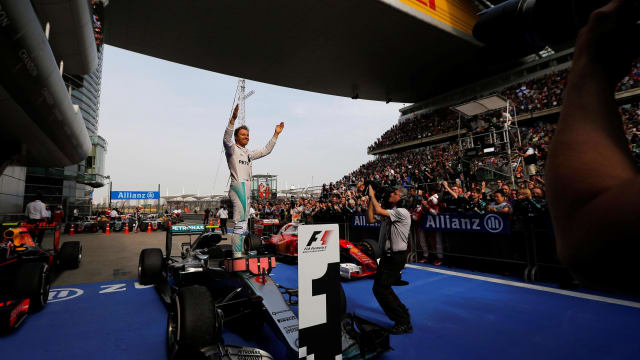1961 Dutch Grand Prix (15 starters)
The field winds it's way through the dunes on lap one at the 1961 Dutch Grand Prix at Zandvoort. All 15 cars would still be running at the flag. © Sutton Motorsport Images
Formula One’s visit to Zandvoort in 1961 has a remarkable place in the history books, as the only Grand Prix in which every car that started not only made it to the finish, but did so without stopping for a fuel top up or fresh tyres.
There is a slight caveat: Masten Gregory and Ian Burgess were both on the reserve list, but didn’t end up starting the race. But of the 15 drivers who made the grid, all saw the chequered flag. Wolfgang von Trips won the race for Ferrari, with team mate Phil Hill following him home after a fierce fight with Lotus’s Jim Clark, who injected much of the action into the two-hour event. BRM’s Graham Hill, who started fifth, was the last man to finish on the lead lap in eighth; Porsche’s Hans Herrmann was three laps down at the flag, in 15th. It would be another 44 years before the feat was repeated…
2005 United States Grand Prix (6 starters)
The six Bridgestone runners line up on the grid at the start of the 2005 United States Grand Prix at Indianapolis. © Sutton Motorsport Images
Few remember the 2005 United States Grand Prix fondly - but the scenes that caused so much controversy and contention also helped the race secure a place on this list.
All 20 cars entered for the event took part in the parade lap, but only six actually progressed onto the starting grid, with the remainder pouring back into the pit lane. Why? Because Michelin, concerned about the durability of their tyres following a fierce crash for Ralf Schumacher on the unforgiving Indianapolis banking during Friday practice, advised their teams not to compete, leaving the Bridgestone-shod runners to race on their own.
What followed was one of the strangest starts in history, and one of the oddest races, with Michael Schumacher and Ferrari team mate Rubens Barrichello completing an easy one-two and Jordan’s Tiago Monteiro completing the podium as ‘best of the rest’. The other Jordan of Narain Karthikeyan and the Minardis of Christijan Albers and Patrick Friesacher completed the finishers as every car made it to the flag for only the second time in history, albeit in rather bizarre circumstances.
2005 Italian Grand Prix (20 starters)
Eventual winner Juan Pablo Montoya leads the 20-car pack through the chicane at the start of the 2005 Italian Grand Prix at Monza. © Sutton Motorsport Images
After the controversy at Indianapolis, 2005 served up another ‘full house’ of classified finishers just two months later at Monza - and this time the entire 20-car grid made it to the end.
That isn’t to say the race was without incident. Much of the drama came at the start - David Coulthard snagged Renault’s Giancarlo Fisichella and, as the Scot slowed, Williams’ Mark Webber was caught unaware and piled into the back of Coulthard’s Red Bull. All three were able to continue, though - Fisichella even managed to finish fifth.
The race also featured a rare off late on for Michael Schumacher (who finished 10th as a result) and tyre concern at McLaren, which forced runaway leader Kimi Raikkonen to pit, and meant Juan Pablo Montoya faced a very nervous final lap as his rears were almost down to the carcass. The tyre held, and Montoya was victorious at the head of a 20-car field.
2011 European Grand Prix (24 starters)
Sebastian Vettel led all the way from lights to flag at the 2011 European Grand Prix in Valencia where every car finished. © © Sutton Motorsport Images
The Valencia Street Circuit may only have been on the F1 calendar for five years, but in that time it managed to set a record that is still unsurpassed: the most classified finishers in any race in world championship history.
It came during a relatively routine Grand Prix in 2011, which was won by polesitter Sebastian Vettel - the Red Bull driver’s sixth win from the opening eight races. Team mate Mark Webber finished third behind Fernando Alonso, but was in danger of falling out of the race entirely with gearbox issues, which prompted Red Bull to urge him to slow.
Mercedes’ Michael Schumacher came close to retiring as well, although entirely through personal error - exiting the pits, he misjudged the distance to Vitaly Petrov, ploughing into the side of the Renault. Petrov was able to continue, while Schumacher limped back to the pits en route to finishing 17th, and one lap down, at the flag.
2015 Japanese Grand Prix (20 starters)
Despite some shenanigans at the start, all 20 cars were classified finishers at Japan in 2015. © Sutton Images
On several occasions during the 2015 race at Suzuka it seemed likely that at least one of the frontrunners would be eliminated. Polesitter Nico Rosberg was the most obvious candidate: after nearly coming together with Mercedes team mate Lewis Hamilton at the start, he also had to be wary of an overheating engine.
But the German survived, as did Red Bull’s Daniel Ricciardo and Williams’ Felipe Massa who did touch, both picking up punctures, but who were able to continue after traipsing back to the pits with three wheels on their wagons.
Only one car was not actually running at the bitter end – Felipe Nasr’s Sauber which had given up the ghost two laps from the flag. The Brazilian had, however, covered more than enough ground to be a classified finisher in 20th.



















